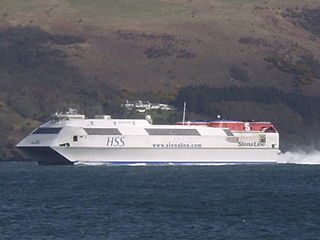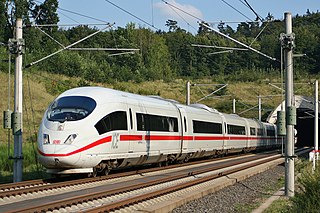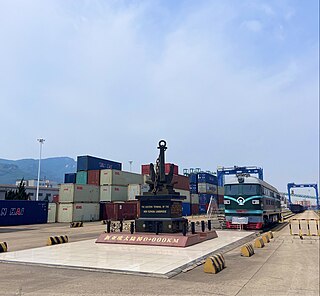 W
WRail freight transport is the use of railroads and trains to transport cargo as opposed to human passengers.
 W
WAccompanied combined transport is a form of intermodal transport, which is the movement of goods in one and the same loading unit or road vehicle, using successively two or more modes of transport without handling the goods themselves in changing modes. More specifically, accompanied combined transport is one of the two types of combined transport, which is intermodal transport where the major part of the journey is by rail, inland waterways or sea, and any initial and/or final legs carried out by road are as short as possible.
 W
WClass districts were a classification system for railway goods wagons used by the Deutsche Reichsbahn (1920–1945) in Germany between the wars.
 W
WIn rail transport, distributed power (DP) is a generic term referring to the physical distribution—at intermediate points throughout the length of a train—of separate motive power groups. Such "groups" may be single units or multiple consists, and are remotely controlled from the leading locomotive. The practice allows locomotives to be placed anywhere within the length of a train when standard multiple-unit (MU) operation is impossible or impractical. DP can be achieved by wireless or wired (trainlined) means. Wired systems now provided by various suppliers use the cabling already extant throughout an ECP train.
 W
WThe Eurasian Land Bridge, sometimes called the New Silk Road, is the rail transport route for moving freight and passengers overland between Pacific seaports in the Russian Far East and China and seaports in Europe. The route, a transcontinental railroad and rail land bridge, currently comprises the Trans-Siberian Railway, which runs through Russia and is sometimes called the Northern East-West Corridor, and the New Eurasian Land Bridge or Second Eurasian Continental Bridge, running through China and Kazakhstan. As of November 2007, about one percent of the $600 billion in goods shipped from Asia to Europe each year were delivered by inland transport routes.
 W
WA multiple-unit train or simply multiple unit (MU) is a self-propelled train composed of one or more carriages joined together, which when coupled to another multiple unit can be controlled by a single driver, with multiple-unit train control.
 W
WA hood is a rigid cover to protect a load on a flatcar, gondola or a coil car. Gondola hoods developed from loose tarpaulin covers that were deemed unsatisfactory in damp climates; but tarpaulins are still used as hoods in some cases. For some gondola loads, hoods made of fiberglass were sufficient. The hoods on coil cars were originally permanently attached to the cars when they were developed in the mid-20th century.
 W
WIn freight rail transport, interchange is the practice of railroads conveying freight cars from other companies over their lines. This benefits shippers, whose cargo might otherwise have to be transhipped if the point of origin and destination are not both served by the same company.
 W
WThe International North–South Transport Corridor (INSTC) is a 7,200-km-long multi-mode network of ship, rail, and road route for moving freight between India, Iran, Afghanistan, Azerbaijan, Russia, Central Asia and Europe. The route primarily involves moving freight from India, Iran, Azerbaijan and Russia via ship, rail and road. The objective of the corridor is to increase trade connectivity between major cities such as Mumbai, Moscow, Tehran, Baku, Bandar Abbas, Astrakhan, Bandar Anzali, etc. Dry runs of two routes were conducted in 2014, the first was Mumbai to Baku via Bandar Abbas and the second was Mumbai to Astrakhan via Bandar Abbas, Tehran and Bandar Anzali. The objective of the study was to identify and address key bottlenecks. The results showed transport costs were reduced by "$2,500 per 15 tons of cargo". Other routes under consideration include via Kazakhstan and Turkmenistan.
 W
WLa Bestia, also known as El tren de la muerte and El tren de los desconocidos, refers to a freight train that starts its route in Chiapas state in southern Mexico, near the border of Guatemala. From there it travels north to the Lecherías station on the outskirts of Mexico City, where it connects with a network of Mexican freight trains heading to different points on the U.S. border. It is estimated that each year, between 400,000 and 500,000 migrants, the majority of whom are from El Salvador, Guatemala, and Honduras, ride atop these trains in the effort to reach the United States. Although these trains are regarded as a free form of travel that allows migrants to avoid Mexico's numerous immigration checkpoints and 48 detention centers, the risks are high and many riders are left with life-altering injuries that limit their capacity to work.
 W
WLoad securing, also known as cargo securing, is the securing of cargo for transportation. According to the European Commission Transportation Department “it has been estimated that up to 25% of accidents involving trucks can be attributable to inadequate cargo securing”. Cargo that is improperly secured can cause severe accidents and lead to the loss of cargo, lives, and vehicles, or cause environmental hazards.
 W
WThe long hood of a hood unit-style diesel locomotive is, as the name implies, the longer of the two hoods on a locomotive, particularly American-type freight locomotives.
 W
WThe length of a train may be measured in number of wagons or in metres for general freight. Train lengths and loads on electrified railways, especially lower voltage 3000 V DC and 1500 V DC, are limited by traction power considerations. Drawgear and couplings can be a limiting factor, tied in with curves, gradients and crossing loop lengths.
 W
WA merry-go-round train, often abbreviated to MGR, is a block train of hopper wagons which both loads and unloads its cargo while moving. In the United Kingdom, they are most commonly coal trains delivering to power stations. These trains were introduced in the 1960s, and were one of the few innovations of the Beeching axe, along with investment from the CEGB and the NCB into new power stations and loading facilities.
 W
WThe New Eurasian Land Bridge, also called the Second or New Eurasian Continental Bridge, is the southern counterpart to the Eurasian Land Bridge and runs through China and Central Asia with possible plans for expansion into South and West Asia. The Eurasian Land Bridge system is important as an overland rail link between China and Europe, with transit between the two via Central Asia and Russia.
 W
WAn ore dock is a large structure used for loading ore onto ships, which then carry the ore to steelworks or to transshipment points. Most known ore docks were constructed near iron mines on the upper Great Lakes and served the lower Great Lakes. Ore docks still in existence are typically about 60 feet (18 m) wide, 80 feet (24 m) high, and vary from 900 feet (270 m) to 2,400 feet (730 m) in length. They are commonly constructed from wood, steel, reinforced concrete, or combinations of these materials.
 W
WPrecision railroading or precision scheduled railroading (PSR) is a concept in freight railroad operations pioneered by E. Hunter Harrison in 1993, and adopted by every North American Class I railroad since. It shifts the focus from older practices, such as unit trains, hub and spoke operations and individual car switching at hump yards, to emphasize point-to-point freight car movements on simplified routing networks. Under PSR, freight trains operate on fixed schedules, much like passenger trains, instead of being dispatched whenever a sufficient number of loaded cars are available. In the past, container trains and general merchandise trains operated separately; under PSR they are combined as needed. Inventories of freight cars and locomotives are reduced and fewer workers are employed for a given level of traffic. The result is often substantial improvement in railroad operating ratios, and other financial and operating metrics, at the cost of criticism of poorer service and long-term capacity issues.
 W
WIn philately a railway stamp is a stamp issued to pay the cost of the conveyance of a letter or parcel by rail.
 W
WIn rail transport, a retarder is a device installed in a classification yard used to reduce the speed of freight cars as they are sorted into trains.
 W
WIn rail transportation, a rolling highway, or rolling road is a form of combined transport involving the conveying of road trucks by rail, referred to as Ro-La trains. The concept is a form of piggyback transportation.
 W
WA rotary car dumper or wagon tippler (UK) is a mechanism used for unloading certain railroad cars such as hopper cars, gondolas or mine cars. It holds the rail car to a section of track and then rotates the track and car together to dump out the contents. Used with gondola cars, it is making open hopper cars obsolete. Because hopper cars require sloped chutes in order to direct the contents to the bottom dump doors (hatches) for unloading, gondola cars allow cars to be lower, thus lowering their center of gravity, while carrying the same gross rail load. The "Double Rotary" coal gondola or coal hopper is required for compatibility.
 W
WA freight house is a building owned and operated by a railroad for receiving, loading, unloading, and temporary storage of less-than-car load (LCL) freight. Having a protected area for temporary freight storage improves efficiency by allowing railroads to accommodate customers' delivery and pickup schedules without leaving boxcars idle at loading points and destinations. A typical freight house has at least one trackside door with one or more doors for trucks or wagons to load and unload on the opposite side of the building.
 W
WA goods station or freight station is, in the widest sense, a railway station where, either exclusively or predominantly, goods, such as merchandise, parcels, and manufactured items, are loaded onto or unloaded off of ships or road vehicles and/or where goods wagons are transferred to local sidings.
 W
WOn June 3, 2016, a Union Pacific train with 96 tank cars carrying Bakken oil from New Town, North Dakota to U.S. Oil and Refining in Tacoma, Washington derailed in the Columbia River Gorge near Mosier, Oregon. 16 of the 96 cars derailed after the train's emergency brake system about 18 cars back from the engines engaged - several cars then caught fire. By 5pm large explosions were coming from the tankers. All of the tank cars were modern CPC-1232 design.
 W
WA unit train, also called a block train or a trainload service, is a train in which all cars (wagons) carry the same commodity and are shipped from the same origin to the same destination, without being split up or stored en route. They are distinct from wagonload trains, which comprise differing numbers of cars for various customers.